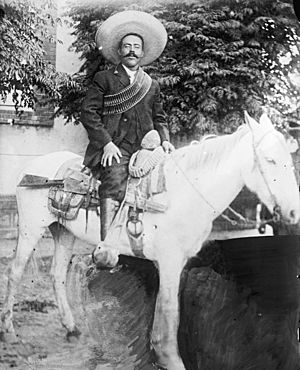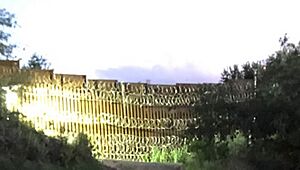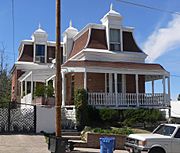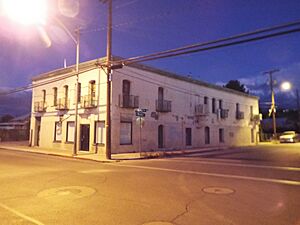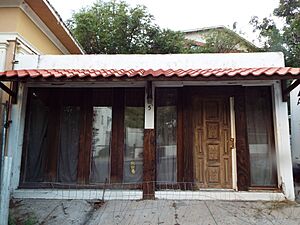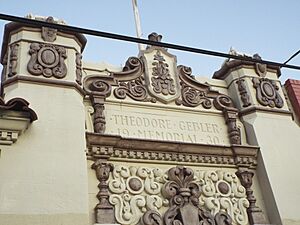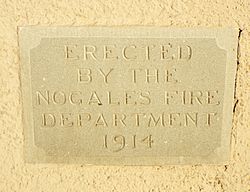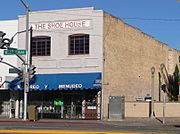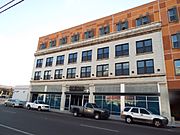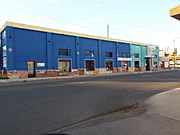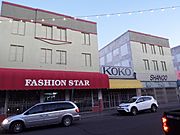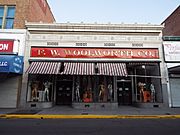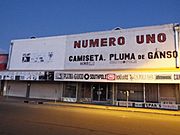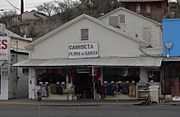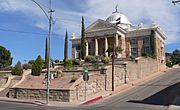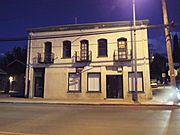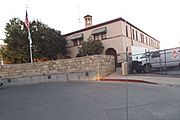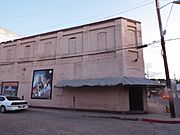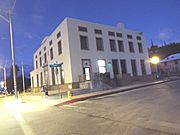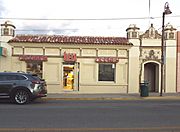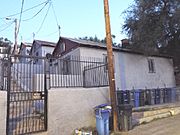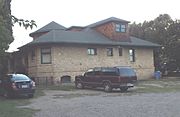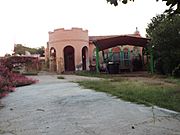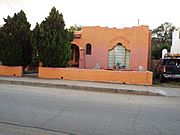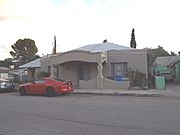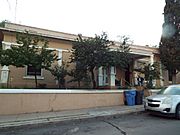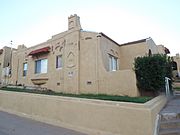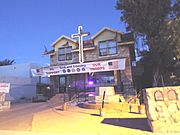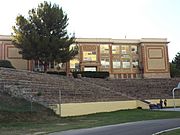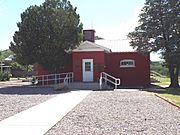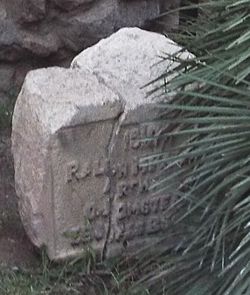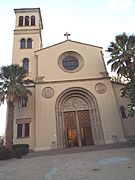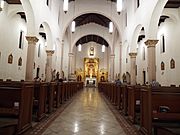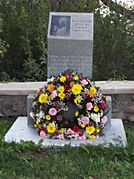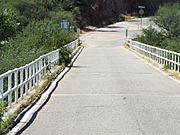List of historic properties in Nogales, Arizona facts for kids
Quick facts for kids
List of historic properties
in Nogales, Arizona |
|
|---|---|
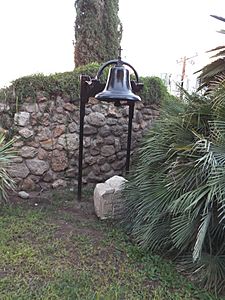
1910 Sacred Heart Church Bell
|
|
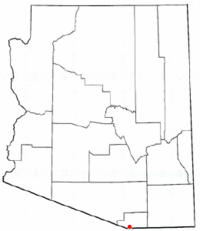
Location of Nogales in Santa Cruz County, Arizona.
|
Welcome to Nogales, Arizona! This city in Santa Cruz County is right on the border with Mexico. It's separated from its twin city, Nogales, Sonora, by a tall steel 'Wall'. Nogales is often called the 'Gateway to Mexico'. Both cities have a long history, going back thousands of years. Ancient people used to trade here, making it an important spot. This article shares some of the most important historic buildings and places in Nogales.
Contents
Nogales: A Look Back in Time
Early People and Spanish Explorers
The land where Nogales sits was once home to the Anasazi tribe. The Santa Cruz River and nearby creeks offered great fishing. The area was also perfect for farming and raising animals. Scientists have found old settlements and rock carvings from the Anasazi. Later, the Hohokam, Apache, and Yaqui tribes lived along these same rivers.
In 1539, a Spanish explorer named Fray Marcos de Niza came to this area. He was on his way to what is now New Mexico. Marcos de Niza was the first European to explore Arizona. The old paths used by Native Americans became known as "El Camino Real," which means "The King's Highway." The main tribes here then were the Sobaipuri and Papago.
In 1692, Father Eusebio Francisco Kino arrived as a missionary. He wanted to teach the native people about Catholicism. This area became part of his "La Mission en Guevavi." For 20 years, he traveled through Southern Arizona. He taught people about farming and shared his faith. The name Nogales means "black walnut" in Spanish. This is because many walnut trees once grew in the mountain pass here.
The mission period ended in 1768. In 1821, Mexico won its independence from Spain. Arizona, which was part of "New Spain," then became part of Mexico.
American Settlers Arrive
In 1854, the United States bought this land from Mexico. This was called the Gadsden Purchase. People from the eastern U.S. began to move here. Large Spanish land grants were divided up. New settlers came to farm and ranch. The U.S. Military protected them from Apache attacks.
However, many soldiers left during the American Civil War (1861-1865). Fort Buchanan, a small army post, was taken over by Apaches. Miners, ranchers, and farmers were left unprotected. Many moved away. After the Civil War ended in 1865, things changed.
In 1867, the U.S. Army set up Camp Crittenden near Sonoita. This camp helped protect American pioneers from the Apache. Miners, ranchers, and farmers then returned to the area.
The Border Wall: A Changing Boundary

Tensions grew along the border when the Mexican Revolution started in 1910. Nogales, Arizona, had a large military base. Ten thousand soldiers, many of them African-Americans, were stationed here. This military presence brought many new businesses to Nogales.
In 1913, a big battle happened in Nogales, Sonora. Pancho Villa and his soldiers won and took control. In 1915, Villa's men fired into the U.S. from Mexico. U.S. soldiers crossed the border and fought back.
During World War I, Germany tried to get Mexico to declare war on the U.S. This made the U.S. watch the border closely. They wanted to stop smugglers and spies.
The first border fence was built between 1909 and 1911. It was a barbed wire fence. The U.S. government put it up to stop cattle from wandering between countries. The mayor of Nogales, Mexico, also ordered a fence to be built. Mexican workers built it. A metal marker showed the international border.
On August 27, 1918, a fight broke out at the fence. An unknown man tried to cross into Mexico and wouldn't stop. Both sides started shooting. This event is known as the Battle of Ambos Nogales. Twelve Mexicans and Americans were killed, including the mayor of Nogales, Mexico. Today, the fence is a 20-foot-high steel wall. It has even been reinforced with razor wire.
Historic Places in Nogales
The Pimeria Alta Historical Society and Museum is in the Old Nogales City Hall. This building was built in 1914. The museum shares the history of the border area. A group of citizens started the society in 1948 to save the area's history. Nogales, Arizona, became a city in 1893.
Many historic properties in Nogales are listed on the National Register of Historic Places. This list helps recognize important places. However, being on the list doesn't always stop an owner from tearing down a building.
Nogales has three historic districts. It also has many individual properties listed as historic.
Historic Districts
A historic district is an area with many old buildings. These buildings are important to the city's history. They are protected by public review. Here are some historic districts in Nogales:
- The Crawford Hill Historic Residential District is a large neighborhood. It has 216 buildings from different times in Nogales' history. It was listed in the National Register of Historic Places on August 29, 1985.
- The Marsh Heights Historic District was planned in 1905 and built in 1909. It was developed by George F. Marsh, a well-known businessman. This neighborhood is built around a central hilltop square. It was listed on October 29, 1985.
- The Pennington Rural Historic Landscape is a historic farm area. It shows what Anglo-American farming was like after the U.S. bought the land from Mexico. It includes an old stone cabin, a field, and an adobe ruin. The stone cabin might be the oldest house built by Anglo-Americans in Arizona. The field has been farmed since 1858. This area was listed on February 10, 2000.
Historic Buildings
Here are some of the historic buildings in Nogales:
- Arizona-Sonora Manufacturing Company Machine Shop (1901): This is the oldest industrial building in Nogales. It was part of a big company that employed many people.
- J.E. Wise Building (1918): This building has the oldest newspaper and printing business in Nogales.
- Old Nogales City Hall and Fire Station (1914): The Pimería Alta Historical Society uses the first floor as a museum today.
- George B. Marsh Building (1905): This building was owned by George Marsh, an important early businessman. It once held the post office and telephone exchange.
- A.S. Noon Building (1900): Built by A. S. Noon, whose family helped shape Nogales. It once had a store run by a Chinese merchant.
- The Bowman Hotel (1917): This is the oldest hotel building still standing in Nogales. It was linked to Wirt G. Bowman, a key businessman and politician.
- Burton Building (Ed Burton & Son Building) (1916): One of three hotels built by Edward Burton. It helped develop Grand Avenue.
- Nogales Electric Light, Ice & Water Company Power House (1915): The only building left from when Nogales first got electric power.
- S.H. Kress & Co. Building (1924): This building was once a "five and dime" department store. You can still see "Kress" on its front.
- The Montezuma Hotel (1926): This was a very important building on Morley Avenue. It was a center for business and social life.
- F. L. Woolworth & Co. Building (1920): This building has a unique style for Nogales. It's the only one with a terra cotta front.
- Jose Piscorski Building (1916): Joseph Piscorski, a local businessman, built this. It was once a hotel and boarding house.
- Las Dos Naciones Cigar Factory (1897): Richard Lewis Fleisher started the only cigar business in the Southwest here.
- The Santa Cruz County Courthouse (1904): This three-story building is a landmark in the city.
- U.S. Custom House and U.S. Inspection Office (1930): This small building is a unique border inspection station.
- Hotel Blanca (1917): Built as a hotel, it is now empty.
- The U.S. Custom House (1935): This building is right at the U.S./Mexico border. It shows how important Nogales was as a border crossing.
- The Nogales Steam Laundry Building (1926): This was a steam laundry. It's one of only four buildings left that show Nogales' old industries.
- U.S. Post Office and Immigration Station (1923): This is one of only six post offices built in the western U.S. between 1920 and 1926.
- The Theodore Gebler Memorial Building (1930): Theodore Gebler left money in his will to build this. It helps people in need in Santa Cruz County.
- The Elks Lodge Building (BPO6) (1930): This building was once the headquarters for the Elks Lodge.
Historic Houses
Many houses in Nogales are also important to its history. Here are some of them:
- 10 Cottages on Short Street (1900): These concrete cottages were built for workers. They are special because they show an early way of building with concrete in homes.
- George Dunbar House (1918): This was the home of George Dunbar, who developed many parts of Nogales.
- W.G. Bowman House (1918): Built for Wirt G. Bowman, a very important businessman and politician in Nogales.
- Frank F. Cranz House (1900): This is the largest Queen Anne style house in Nogales. It was built for Frank F. Cranz, a mining man and mayor.
- Mediterranean Style House on 215 Walnut Street (1900): A great example of a Mediterranean style home in Nogales.
- Mediterranean Style House on 245 Walnut Street (1900): This brick house also shows a unique local Mediterranean style.
- House at 365 Walnut Street (1909): Another historic home on Walnut Street.
- House at 459–465 Walnut Street (1900): This house is a good example of concrete home building. It has classical columns.
- Three Mediterranean Cottages on Pajarito Street (1920): These cottages show the growth of Nogales after World War I.
- Hugo Miller House (1912): This Craftsman Bungalow is the best example of concrete brick building in Nogales homes. It was home to Hugo Miller, a mining expert.
- House at 565 Morley Avenue (1915): This house has unique features from different architectural styles.
- The Senator James A. Harrison House (1915): This is the best-preserved two-story bungalow in Nogales. It was built for Senator James A. Harrison, a politician and businessman.
- Historic houses
Historic Schools
Nogales also has important historic school buildings:
- Santa Cruz Schoolhouse (1920): This is one of many "Little Red Schoolhouses" built in the Santa Cruz Valley. Even when times were tough for farmers, they built these schools.
- Old Nogales High School (1917): This is the oldest public school building still standing in Nogales. It's also the largest building in the Second Renaissance style in the city.
Historic Churches
Places of worship also have a rich history in Nogales:
- The Guevavi Mission Ruins (founded 1691): This mission was started by Jesuit priests Kino and Salvatierra. It was an important religious center in early Arizona.
- Sacred Heart Church (1928): This church has served the Catholic community in Nogales since 1897. It opened in 1928 after two years of building.
Other Historic Sites
Here are some other important historic places in the Nogales area:
- Santa Cruz Bridge No. 1 (1917): This bridge was one of the first major bridges built by the Arizona State Engineer's Office. It was very important for travel in southern Arizona for many years. It's one of the oldest concrete girder bridges still used in the state.
- The Hacienda Corona de Guevavi (Bed & Breakfast) (1935): This hacienda was once a ranch headquarters. It was painted by Mexican artist Salvador Corona. It even became a Hollywood getaway after its owner lent cattle for a John Wayne movie!
- The Camp Little Cottages and Historical Marker (1915): These cottages were military housing for Camp Little. This camp was a large army post in Nogales during the Mexican Revolution. A historical marker at City Hall tells its story.
- Pete Kitchen Ranch (established around 1862): This ranch is thought to be the first permanent American ranch in Arizona. It was built by Pete Kitchen. The site was used by the Anasazi long ago and visited by explorer Juan Bautista de Anza.
See also


